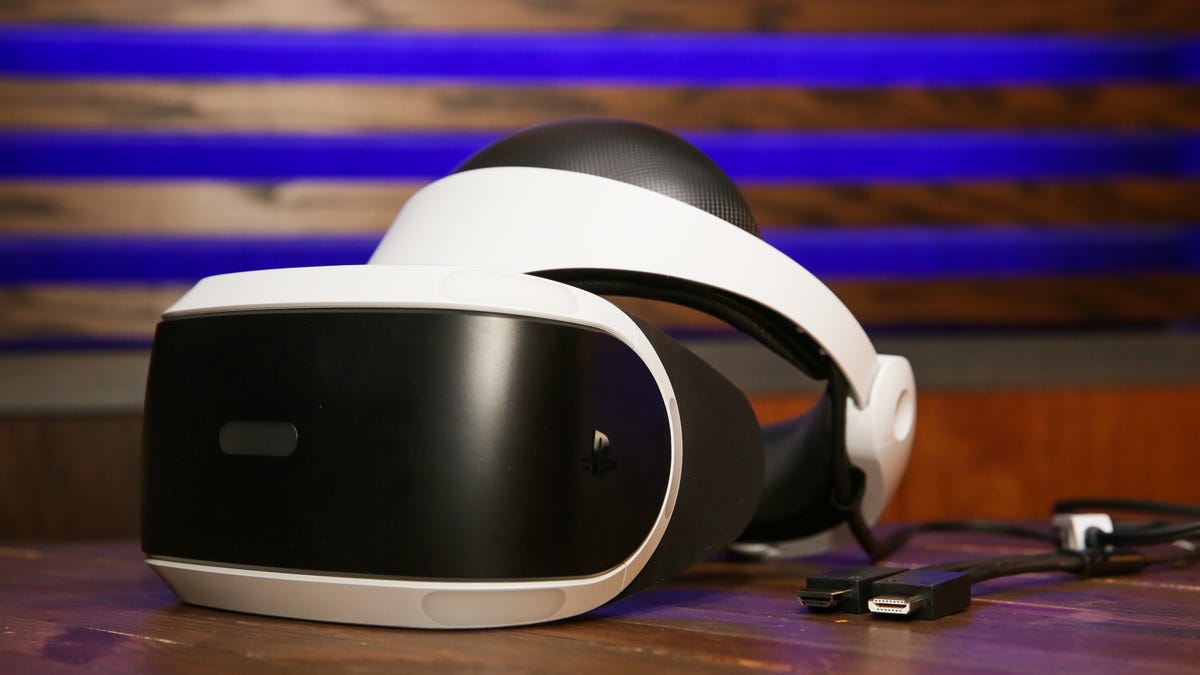Sony's VR plans for PlayStation 5 could involve eye tracking, wireless and more
PlayStation Global Head of R&D Dominic Mallinson discusses what's next and why there's no rush yet for a new headset

PlayStation VR may get upgrades, but not necessarily when PS5 debuts.
VR headsets have been arriving in force in 2019, with new hardware from Oculus, Valve, and Vive. But Sony's PlayStation VR, which debuted back in 2016, hasn't made its next evolutionary leap yet. That time is coming, but it likely won't be alongside the debut of the PlayStation 5.
At Toronto's Collison conference, Sony's Global Head of R&D for PlayStation, Dominic Mallinson, sat down with CNET to discuss what's on the horizon for PSVR, and what we might see next. None of these are guarantees, but they could be key features of PSVR's next leap.
Something wireless, and lighter
The PSVR has been a success story relative to other VR hardware, selling over 4.2 million headsets so far, but the PlayStation 4's install base of 96.8 million dwarfs that. Mallinson admits PSVR "does need to evolve. It's not quite there yet as a mass market proposition." A key step could be making it easier and less cord-tangly. "We do want it to be lighter weight, and easier to put on, less cables, less mess."
But a wireless option could take the form of an add-on, instead of the default. "Wireless suffers from the issue of being expensive," Mallinson says. "If you don't care about cables, then it's a lot cheaper than to have a wireless system. But at the same time, having wireless just makes you so much more free."
Recent patent filing reports show designs indicating a wireless headset. The current PlayStation VR is relatively bulky, and its tether and break-out box means gameplay needs to happen in close range of the PS4.
Eye tracking is in play
No mainstream VR headsets use eye tracking yet, but eye tracking (or gaze tracking) is something that PlayStation's actively considering, and Mallinson considers crucial. "That's the one that excites me the most... I think there will come a point in time in the not too distant future when you cannot launch a VR headset without eye tracking." It could have practical benefits, too: eye tracking can help reduce graphics load to make games perform better via a technique called foveated rendering, which could help a game console perform more like a high-end PC. "It's a win-win in that respect," says Mallinson. "For me it's a pretty obvious technology."
PlayStation VR's Move controllers date back to the PS3.
New controllers
Part of the current PSVR design was always about getting to the lowest price possible, which meant using existing PlayStation Move controllers and PS4 cameras instead of VR-specific controllers (while PlayStation VR games can also use the standard DualShock 4, he says Move has won out slightly with developers). "We knew if we went back into the R&D labs and we did something brand-new, we could have created something better than PlayStation Move, but it would have cost more," Mallinson says, but hints that a better solution is coming. "We do recognize that does need to be evolved, and in the future we will obviously replace it."
Could mixed reality be onboard?
Sony's not exploring making a HoloLens for gaming (as far as we know), but there's a possibility that pass-through mixed reality using VR headset cameras could be a part of the picture. "In the future, it's interesting to us," Mallinson says. He sees incorporating real-world things into the VR headset, like the way Oculus Quest can draw magic boundaries while seeing the room with pass-through cameras, is better than trying to drop holograms into actual reality like Magic Leap. "If you are more interested in mixed reality for gaming applications, then I actually think video see through is more compelling and a lot less complicated." Sony's had experience with AR games before, going back to PlayStation 3 games like Wonderbook, or EyePet.
Don't expect a new PSVR to launch alongside PS5
Mallinson seems satisfied with how PlayStation VR rolled out several years after the PlayStation 4 was on the market. The current PSVR will be PS5-compatible, which means a new headset isn't necessary right away. And that could mean Sony waits to debut a new headset for a while. "There's no reason for us to coincide it with a new console. From the point of view of the consumer, to be bombarded with many many things -- oh, you have to buy this, you have to buy that -- is a message that we don't want to send. In some ways, it's good to have a little breathing space between those things."
Don't expect a mobile VR standalone system, either
Mallinson admires Oculus Quest, Facebook's new standalone console-free VR system, but doesn't see Sony taking a similar path yet. "I do applaud them for doing something that is mobile, but it's something you would more likely do in a private living room space. I don't think you'd go out on the road and do this stuff. But I think having no wires, making it light and unencumbered, it is great. So I think going mobile for both reasons is important."
New VR headset or not, VR is gaining traction
While developer interest is high, says Mallinson, the audience is smaller and Sony is still looking to grow the audience. "The fact of life is, you get a little less in terms of commercial movement from the VR titles."
But he sees VR as finally becoming a platform that can work. Sony's recent lineup of VR games has been impressive and some of the PlayStation's best games of 2018 (Moss, Tetris Effect, Astro Bot: Rescue Mission) were VR titles. "We're just reaching that level now where, as a developer you can say, 'OK, I can make money. It's not easy, but I can now make money.'"

